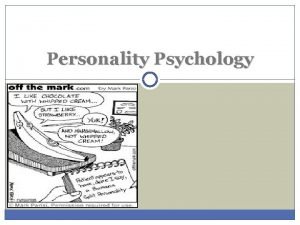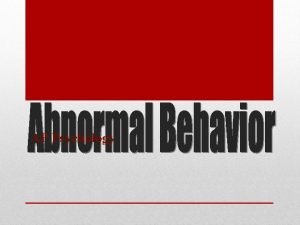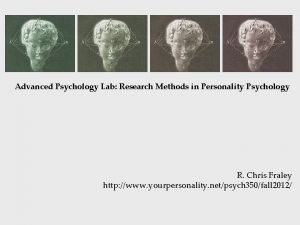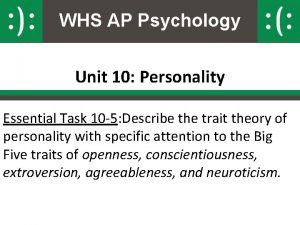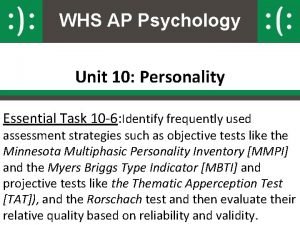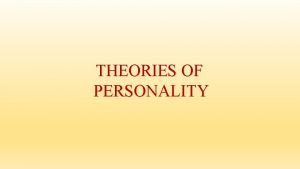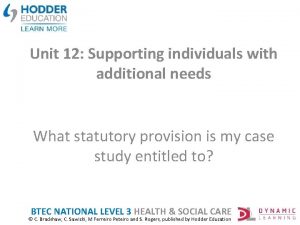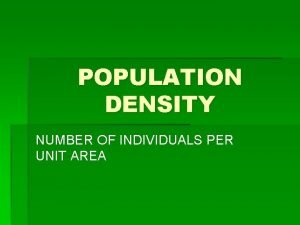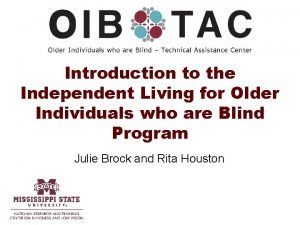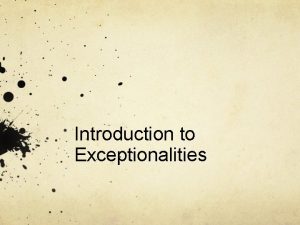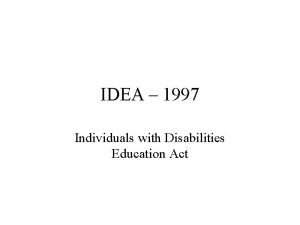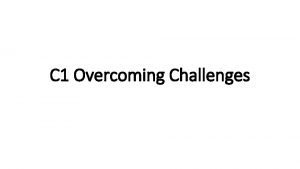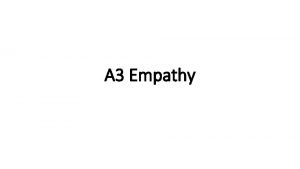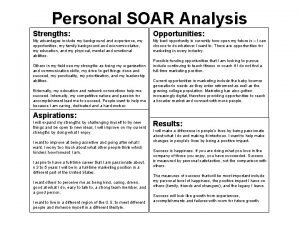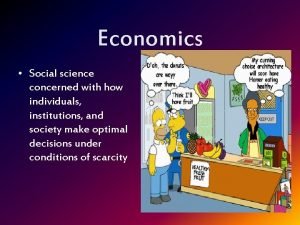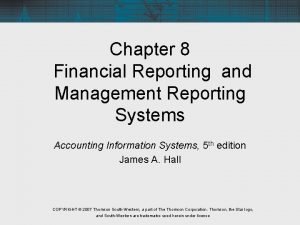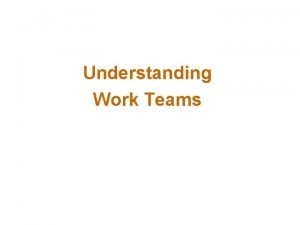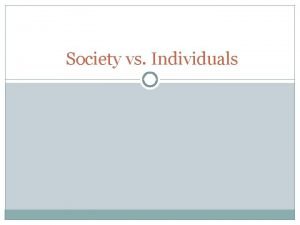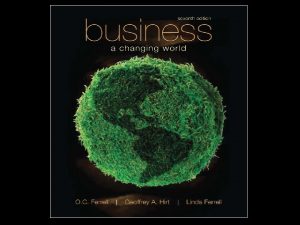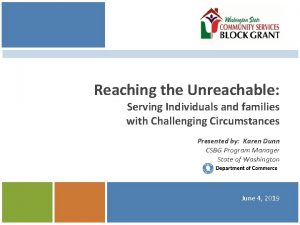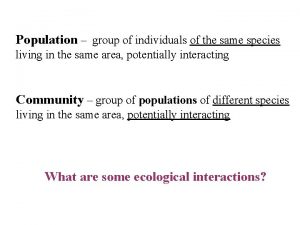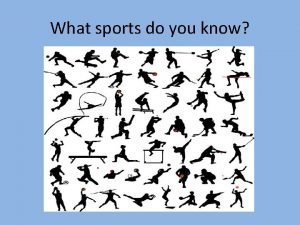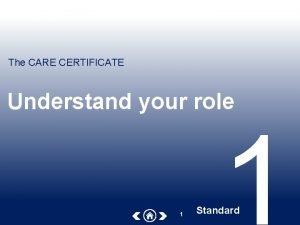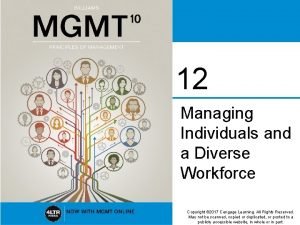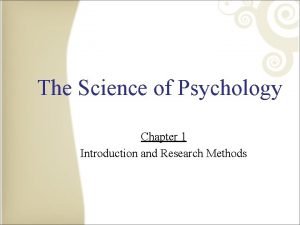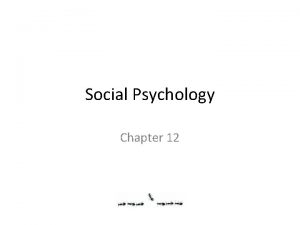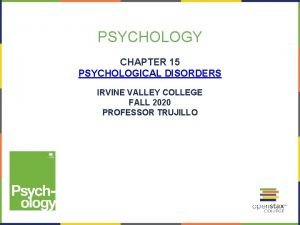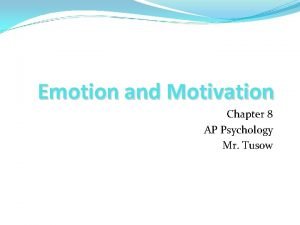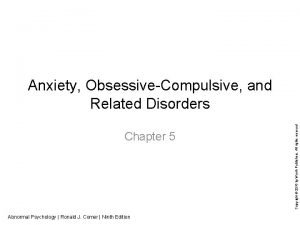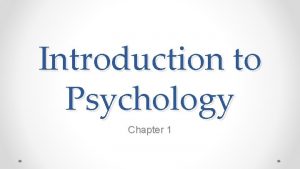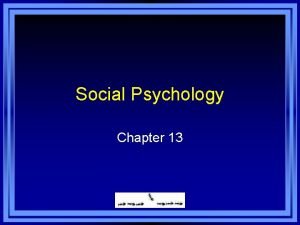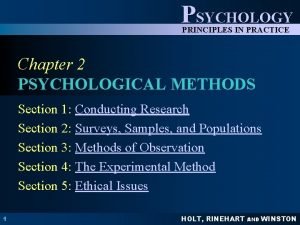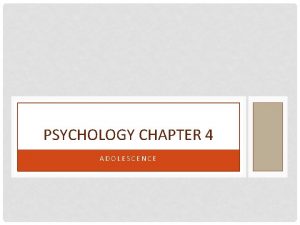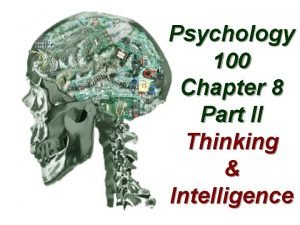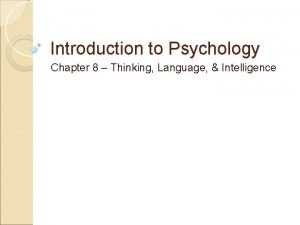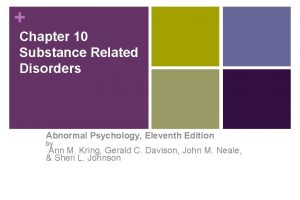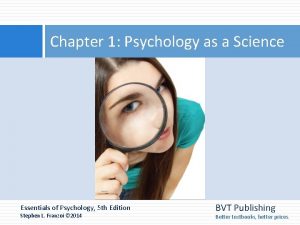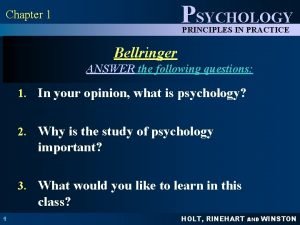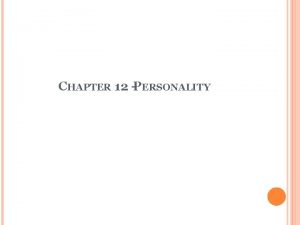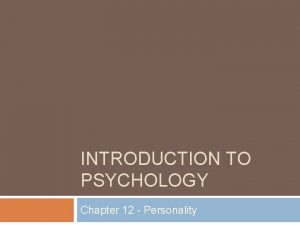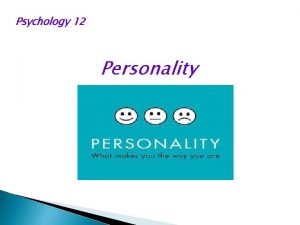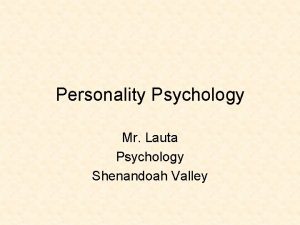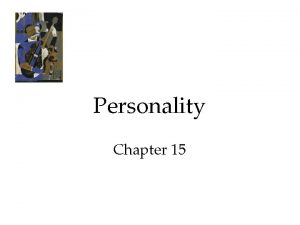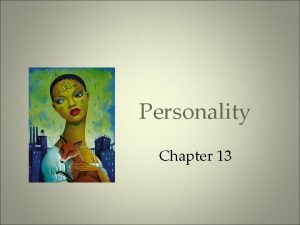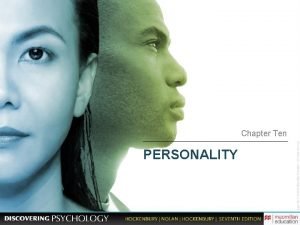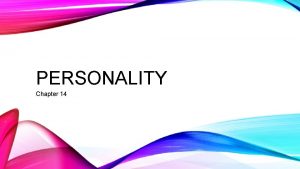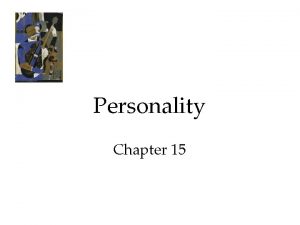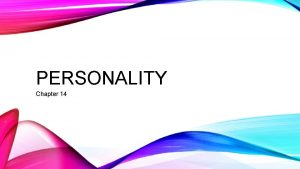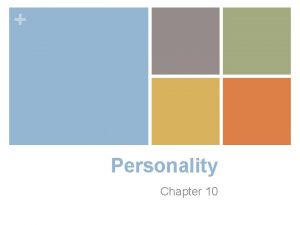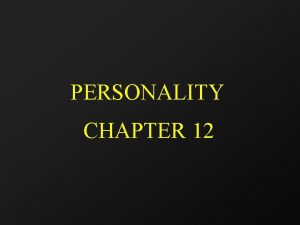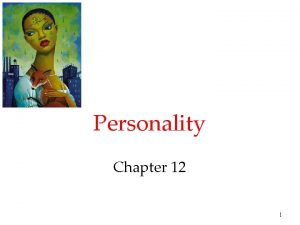Chapter 15 Personality AP Psychology Personality an individuals







































































- Slides: 71

Chapter 15: Personality AP Psychology

Personality - an individual’s characteristic pattern of thinking, feeling, and acting Major personality theories �Freud’s Psychoanalytic Theory �Humanistic Approach �Trait Theory �Social-Cognitive Perspective

Psychoanalytic Perspective of Personality �Sigmund Freud (1856 -1939) �Austrian physician - treated patients with “neurotic” disorders (no physical cause) �Psychodynamic (psychoanalytic) theory – Theory of personality that attributes thoughts and actions to unconscious motives and conflicts �Expose and interpret unconscious tension through: �Free association �Dream analysis �“Freudian slips, ”

Free Association �Used by Freud to explore the unconscious mind �Person relaxes and says whatever comes to mind, no matter how trivial or embarrassing �Trace thoughts to a patient’s unconscious, painful memories (repressed memories? )

Free Association �Hate �Alone �Time �Grandma �Life �Heart �Good �Love �Influence �Impossible

Freudian Slip �A Freudian slip, AKA parapraxis, “slip of the tongue” �Error in speech because of interference of unconscious, repressed, or hidden desire or conflict guided by the super-ego and the rules of correct behavior. �Modern psychoanalytic theory might explain this as simple misreadings or mishearings

Freudian Slips “Good Morning Beheaded – Uh, I mean Beloved!”

Psychoanalytic Theory �Freud believed that the mind is mostly hidden �Unconscious – Beneath our conscious mind is a larger mind with mostly unacceptable thoughts, wishes, feelings, and memories that we are unaware of �Freud believed nothing was accidental �Dreams and free associations were windows to the unconscious

Freud’s Model of the Mind The mind is like an iceberg. It is mostly hidden, and below the surface lies the unconscious mind. The preconscious stores temporary memories.

Personality develops as a result of our efforts to resolve conflicts between our biological impulses and social restraints.

Freud’s Personality Structure - Id �Unconscious portion of personality �The Id unconsciously strives to satisfy basic sexual and aggressive drives �Operates on the pleasure principle �Demands immediate gratification – (infants, impulsive people)

Freud’s Personality Structure - Ego �The ego functions as the “executive” and mediates the demands of the id and superego. �Develops from id as parents, teachers, etc. place restrictions on id behavior �Operates on “reality principle”- Seeks to gratify demands of the id in realistic ways �Voice of conscience

Freud’s Personality Structure - Superego �The superego provides standards for judgment and for future aspirations. �Internalized rules and values of parents and society (develops ages 4 -5) �Voice of conscience that forces ego to consider not only the real but the ideal (How you ought to behave) �As relentless, unreasonable in demands as id


Freud’s Personality Structure

Freud’s Psychosexual Stages �Personality develops during early childhood �Psychosexual stages – stages of development during which the id’s pleasure seeking energies focus on erogenous zones �Failure to resolve conflict at a stage results in fixation – unconscious preoccupation with area of pleasure associated with stage �Affects adult personality characteristics

Freud’s Psychosexual Stages �Oral Stage (1 st year) �Mouth is center of pleasure at this stage �Fixation can come from weaning too early or late �Can result in adult characteristics like overeating, thumb sucking, smoking, childlike dependence (late weaning), “biting” sarcasm (early weaning)

Freud’s Psychosexual Stages �Anal Stage (2 nd year) �Child’s ego develops to cope with parental/societal demands (toilet training clashes with freedom to “go” at will) �Fixation from toilet training too early or harsh → “anal retentiveness” or stinginess/excessive neatness (symbolically withholding feces) �Fixation from training too late/lax → “anal-expulsive” or disorganized, impulsive behavior (symbolically expelling feces)

Freud’s Psychosexual Stages �Phallic Stage (ages 3 -5 years) �Focus shifts to genital area �Oedipus Complex - Boy has sexual desire for mother and wants to eliminate father’s competition for her attention �Fear of castration from father leads ego to repress desires and identify” with father (superego begins to develop) �Girls are believed to experience a similar Electra complex

Freud’s Psychosexual Stages �Latency Period (childhood to puberty) �Peaceful interval where sexual impulses remain in background �Focus on education, same-sex peer play, develop social skills �Genital Stage (adolescence on) �Sexual impulses reappear at conscious level with genitals as focus

Freud’s Psychosexual Stages �Identification – Children eventually cope with threatening feelings, identify with, and try to become like the rival parent �“If you can’t beat ‘em, join ‘em” � Superego gains strength - gain parents’ values � Identify with same-sex parent - part of gender identity �Fixation – the person’s pleasure-seeking energies are locked in a given stage �Can lead to difficulty dealing with authority figures and an inability to maintain stable love relationships


Defense Mechanisms �Defense Mechanisms - Unconscious tactics used by the ego to protect against anxiety & guilt (from id & superego) by preventing material from surfacing or disguising it when it does, or distorting reality

Defense Mechanisms �Repression – banishing anxiety arousing thoughts, feelings, repressed urges slip out in dreams or slip-ups �Regression – an individual faced with anxiety retreats to a more infantile psychosexual stage, where some psychic energy remains fixated (thumb sucking, clinging to mommy)

Defense Mechanisms �Projection – People disguise their own threatening impulses by attributing them to others (“He doesn’t trust me” really means “I don’t trust him”) �Rationalization – offers self-justification explanations in place of the real, more threatening, unconscious reasons for one’s actions. (“I drink with my friends” not “I’m an alcoholic. ” “I’m a social smoker”) �Sublimation – People channel their unacceptable impulses into socially approved activities (paint or play a sport to channel your unconscious desires)

Defense Mechanisms �Displacement – Shifts sexual or aggressive impulses toward a more acceptable or less threatening object or person; redirecting anger toward a safer outlet. (Kick the dog instead of yelling at your wife or child)

Defense Mechanisms �Denial – People refuse to believe or even perceive painful realities. (Deny your wife is cheating on you) �Reaction Formation – the ego unconsciously switches unacceptable impulses to their opposite. People may express feelings that are opposite of their unconscious feelings. (”I love dad” instead of “I hate dad”) All of these defense mechanisms function independently and unconsciously.

Neo-Freudian & Psychodynamic Theorists • Followers of Freud who eventually moved away from some of his theories and ideas • Accept Freud’s basic ideas of: • Id, Ego, & Superego • Importance of the unconscious • Shaping of personality in childhood • Dynamics of anxiety & defense mechanisms. • Placed more emphasis on: • Conscious mind’s role in interpreting experience & coping • Doubted sex & aggression were all-consuming motivations

Neo-Freudians – Alfred Adler �Social, not sexual tensions, crucial for personality development �Most fundamental motive is striving for superiority �Can’t get rid of feelings of inferiority = Inferiority Complex �Compensation - may hide feelings of inferiority by flaunting superficial indicators of superiority such as wealth, status, good looks

Neo-Freudians – Karen Horney �Disagreed with Freud’s male-dominated theory �Culture (social factors) is the main force in the formation of personality, not biological factors �Women envy men’s superior status, not their anatomy �Children need love & security for the formation of a healthy personality, lack of = personality problems such as hostility & anxiety

Neo-Freudians – Carl Jung �Unconscious influences us but contains more than repressed feelings & thoughts. �Collective unconscious – shared sense of universal experiences common to all human beings (unaware of these) �Organized into archetypes – universal concepts that influence our expectations, perceptions, & behavior (Ex. Mother as a symbol for nurturing) �Introduced personality types (no stages) – �Introversion – tendency to reflect on one’s own ability �Extraversion – tendency to focus on the social world

Assessing the Unconscious Mind Projective Tests – provide ambiguous stimuli designed to reveal the hidden unconscious mind �Thematic Apperception Test (TAT)– subjects express inner feelings & interests through the stories they make up about ambiguous scenes. �Rorschach Inkblot Test - uses a set of 10 inkblots to identify people’s inner feelings by analyzing their interpretations of the blots (most widely used)

Explain the following: 1. What has led up to the event shown? 2. What is happening at the moment? 3. What are the characters feeling and thinking? 4. What the outcome of the story was?

Explain the following: 1. What has led up to the event shown? 2. What is happening at the moment? 3. What are the characters feeling and thinking? 4. What the outcome of the story was?



Evaluating the Psychoanalytic Perspective �No empirical way to study the origins & effects of the unconscious �Doubt gender identity comes from overcoming the Oedipus complex �Overestimated parental influence & underestimated peer influence • Freud typically used case studies, which aren’t as reliable as experimentation �High stress enhances memory – powerful negative emotional events are remembered well �Freudian slips are just language mistakes – competition between similar verbal choices in our memory network

Humanistic Perspective �Explains personality by describing how people differ in terms of selfawareness, creativity, decision-making & responsibility �Believe that people have an innate drive that promotes & directs growth and achieving their potential �Focused on “healthy people” rather than troubled clinical cases like Freud.

Abraham Maslow – Self-Actualization �Believed that we are motivated by a hierarchy of needs �We ultimately seek self-actualization – the process of fulfilling our potential

Abraham Maslow – Self-Actualization Studied people who were �Healthy, creative �Notable for their rich and productive lives (Abraham Lincoln, Thomas Jefferson, Eleanor Roosevelt) These people shared certain characteristics: �Self-aware �Self-accepting �Loving & caring �Open & spontaneous �Problem-centered �Not worried about what others think �Few deep relationships �Uneasy about cruelty and meanness

Carl Rogers – Person-Centered Perspective �People are basically good and can reach selfactualization unless in environment that inhibits growth. �Growth is promoted by having an environment with the following three qualities: v. Genuineness v. Acceptance v. Empathy

Carl Rogers – Person-Centered Perspective We are able to grow if surrounded by people with these qualities: �Genuine - Being open with one’s feelings & being transparent and self-disclosing. �Accepting - Unconditional Positive Regard = total acceptance toward another person. �Empathic - Sharing and mirroring our feelings

Humanistic Perspective �Central feature of personality is one’s self-concept – all the thoughts & feelings we have in response to the question, “Who am I? ” �If our self-concept is positive, we perceive the world as positive. �If it is negative, in our own eyes, we fall short of our ideal self. �Used questionnaire to assess person’s sense of self – Who do you ideally want to be vs. who you actually are? �If ideal & actual are nearly alike positive self-concept

Evaluating the Humanistic Perspective Proponents: Critics: �Key to happiness and success = �Research is vague & subjective positive self-concept (Others might not share the values that Maslow & Rogers find to be �Acceptance and empathy positive). nurture positive feelings �People are basically good and can �Encourages individualism, which can lead to self-indulgence, selfishness, & improve erosion of moral restraints �Fails to consider the capacity for evil.

Trait Perspective – Gordon Allport �Ever taken an online personality test? That is the trait perspective! �Allport – one of the 1 st trait researchers �Describe personality rather than explain it. �Sought to describe personality in terms of fundamental traits or identifiable behavior patterns �Traits = Internal characteristics that are stable, consistent over time, and displayed through mulutiple situations

Exploring Traits �There are over 18, 000 words in a dictionary to describe people, so how do we cerate a list of manageable traits we can use to describe personality? (Allport counted them!)

Trait Perspective – �Individual Traits �Cardinal Trait – traits that define someone’s personality so well that the person exemplifies that trait in everything they do �Very rare – Ex. Mother Theresa – kindness & compassion �Central traits (source traits) – most people have – are easily recognized & have a strong influence on personality (caring) �Secondary (surface traits) –more specific to certain situations and change over time, not consistent, convey interests or preferences (competitive)

Factor Analysis – Raymond Cattell �Based his research on Allport’s work �Factor Analysis – statistical method that analyzed multiple variables that are correlated and identifies how those correlations connect with each other �Allowed Cattell to find overarching qualities that connect numerous traits into clusters, reducing the number of traits.

Raymond Cattell’s 16 Source Traits �Came up with 2 overarching types of traits: � Surface Traits - observable behaviors � 16 Source Traits – fundamental characteristics that drive personality & result in the observable surface traits � Organized the source traits into 16 pairs, each pair forming a continuum & developed a test called the 16 Personality Factor (PF) Psychometric Questionnaire to measure them


Hans & Sybil Eysenk �Also used Factor Analysis to analyze traits �Arrived at 3 genetically-influenced dimensions of personality (temperaments) � Introversion vs Extroversion – needing either more external stimuli or less � Neuroticism vs Stability – degree of emotional stability � Psychoticism vs Normality– the degree of aggression or nonconformity

Eysenk Model of Personality

Assessing Traits �Personality Inventory - people respond (self-report) to items designed to gauge a wide range of feelings and behaviors. �Used to assess several personality traits at once. �Minnesota Multiphasic Personality Inventory (MMPI) - most extensively researched & widely used �most commonly used by mental health professionals to assess and diagnose mental illness �Empirically Derived Test - created by determining which test items discriminate between different groups of people on some variable. �Objective (Scored by a computer) �Social desirability - People can lie

Myers-Briggs Type Indicator (MBTI) �Personality test taken by 2 million people a year �Sorts people into 16 basic personality types based on Carl Jung‘s theories �Not really a "test" in that there are no right or wrong answers and one type is not better than any other type. �Goal is to simply offer further information about your own unique personality. �Many challenge its reliability and validity

The Big-Five Model �Paul Costa & Robert Mc. Crae felt that Raymond Cattell identified too many traits and Hans Eysenck too few �Currently the most widely accepted model of traits �Used factor analysis to develop five central source traits • Openness • Conscientiousness • Extraversion • Agreeableness • Neuroticism • Research has shown these traits to be stable in adulthood, influenced by genetics, and a predictor of behavior.


Evaluation of Trait Theory �Trait theory is excellent at labeling behavior, but does not explain why a person acts a certain way �Does not also consider how situations affect a person’s personality �The Big-Five Model is widely used but still does not explain personality

Social-Cognitive Perspective �Albert Bandura - views personality as an interaction of our traits with our situations �Social – We learn our behaviors through conditioning, or observing and modeling. (How we interact with our environment) �Cognitive – What we think about our situations affects our behavior

Reciprocal Determinism – the interacting influences of behavior, internal cognition, & environment

Reciprocal Influences 1. Different people choose different environments • Your friends, your media - you chose them and then they in turn help shape you 2. Our personalities shape how we interpret and react to events • Anxious people react to situations differently than calm people 3. Our personalities help to create situations to which we react • How we view and treat people influences how they treat us We are both the products and the architects of our environment


Personal Control �Whether we control the environment or the environment controls us �External locus of control (Julian Rotter) – perception that chance or outside forces beyond our personal control determine our fate �Internal locus of control – perception that we can control our own fate

Personal Control Benefits of having an internal locus of control: ØAchieve more in school ØAct more independently ØEnjoy better health ØFeel less depressed Self-control – the ability to control impulses and delay gratification � Predicts good adjustment � Better grades � Social success

Learned Helplessness vs Personal Control �“Perceived control” is basic to human functioning �Studies show that people thrive when they have empowerment and personal freedom �Learned helplessness – (Seligman) passive resignation – when animals or people experience no control over repeated bad events, they feel helpless, hopeless, and depressed �Drawback – excess freedom can also contribute to decreasing life satisfaction

Learned Helplessness

Optimism vs Pessimism �Attributional style – your way of explaining positive or negative events �Realistic positive expectations can fuel success • Being optimistic can be beneficial to your health • Realistic anxiety over possible failures can lead to efforts to avoid a negative outcome • Excessive optimism can blind us to real tasks and promote “an unrealistic optimism about future life events” • People are most overconfident when most incompetent (Dunning. Kruger Effect)

Exploring the Self �The Self – the center of personality, organizer of our thoughts, feelings, & actions �Can you have several possible selves? Consider… �The self you hope to become �The self you fear you will become �The self you think you are to your friends �The self you think you are to your family �The self you are at school

Exploring the Self �Our self-focused perspective can motivate us or lead us to presume that others are noticing and evaluating us �Spotlight effect - Research studies show we overestimate our concern that others evaluate our appearance, performance, and blunders �Fewer people notice what we presume

Benefits of Self-Esteem �Self-esteem – one’s feelings of high or low self-worth �A successful life results from a healthy self-image �People with high self-esteem… �Feel good about themselves �Have fewer sleepless nights �Succumb less easily to pressure to conform �Are more persistent at difficult tasks �Are less shy and lonely �When self-esteem is deflated, we view ourselves and others critically; if you’re down on yourself, you’re down on others

Self-Serving Bias �Most of us have decent self-esteem Self-Serving Bias – our readiness to perceive ourselves favorably • Research findings: �People accept more responsibility for good deeds than for bad �Most people see themselves as better than average �People accept more responsibility for successes than for failures �Blame unfavorable events or behaviors on external factors

Evaluating the Social-Cognitive Approach �One advantage is that this approach includes cognitive, behavioral, and environmental factors �Critics say that social-cognitive psychologists pays too much attention to the situation and not enough attention to the individual, inner traits, unconscious mind, emotions, and genetics
 Group polarization example
Group polarization example Positive psychology ap psychology definition
Positive psychology ap psychology definition Fundamental attribution error ap psychology
Fundamental attribution error ap psychology Scope of psychology
Scope of psychology Social psychology is the scientific study of
Social psychology is the scientific study of Health psychology definition ap psychology
Health psychology definition ap psychology Structure of personality meaning
Structure of personality meaning Projection defense mechanism example
Projection defense mechanism example Highly dogmatic consumers
Highly dogmatic consumers Nature of personality in psychology
Nature of personality in psychology Evocation personality psychology
Evocation personality psychology Antisocial personality disorder ap psychology definition
Antisocial personality disorder ap psychology definition What is personality
What is personality Unit 10 ap psychology
Unit 10 ap psychology Type a personality
Type a personality Type approach
Type approach Supporting individuals with additional needs
Supporting individuals with additional needs Photo/drawing of individuals/groups/institutions
Photo/drawing of individuals/groups/institutions Risk management for enterprises and individuals
Risk management for enterprises and individuals Gene pool
Gene pool Number of individuals per unit area
Number of individuals per unit area Individuals: an essay in descriptive metaphysics
Individuals: an essay in descriptive metaphysics Older individuals who are blind program
Older individuals who are blind program Individuals with exceptionalities
Individuals with exceptionalities Marcia erikson
Marcia erikson Individuals with disabilities education act of 1997
Individuals with disabilities education act of 1997 Impact of not enabling individuals to overcome challenges
Impact of not enabling individuals to overcome challenges Empathy and establishing trust with individuals
Empathy and establishing trust with individuals Turning individuals into team players
Turning individuals into team players Classification of resources on the basis of exhaustibility
Classification of resources on the basis of exhaustibility The process of attracting individuals on a timely basis
The process of attracting individuals on a timely basis Soar analysis
Soar analysis The social science concerned with how individuals
The social science concerned with how individuals Pseudo team
Pseudo team Gl/frs
Gl/frs Teams typically outperform individuals
Teams typically outperform individuals Society vs individual
Society vs individual Only individuals can be secretaries
Only individuals can be secretaries The activities that independent individuals groups
The activities that independent individuals groups Serving individuals and families
Serving individuals and families Serving individuals and families
Serving individuals and families A group of individuals of the same species
A group of individuals of the same species Healthy confident individuals
Healthy confident individuals Better health for individuals
Better health for individuals It is a sport in which participants compete as individuals
It is a sport in which participants compete as individuals Understand your role
Understand your role Define family matters
Define family matters Initiatives aimed at preventing discrimination
Initiatives aimed at preventing discrimination Surface level diversity
Surface level diversity Ap psychology chapter 14
Ap psychology chapter 14 Operational definition examples behavior
Operational definition examples behavior Chapter 12 social psychology
Chapter 12 social psychology What are the 10 personality disorders
What are the 10 personality disorders Yerkes dodson law ap psychology example
Yerkes dodson law ap psychology example Ronald comer abnormal psychology
Ronald comer abnormal psychology Chapter 10 infancy and childhood
Chapter 10 infancy and childhood Chapter 6 memory psychology
Chapter 6 memory psychology Psychology fifth edition ciccarelli white
Psychology fifth edition ciccarelli white Chapter 10 infancy and childhood review worksheet answers
Chapter 10 infancy and childhood review worksheet answers Introduction to psychology chapter 1
Introduction to psychology chapter 1 Receptive language ap psychology
Receptive language ap psychology Copyright ?
Copyright ? Diathesis psychology
Diathesis psychology Chapter 13 social psychology
Chapter 13 social psychology Psychology chapter 2 section 1
Psychology chapter 2 section 1 Chapter 4 adolescence psychology
Chapter 4 adolescence psychology Thinking chapter in psychology
Thinking chapter in psychology Wisc-v test
Wisc-v test Chapter 10 infancy and childhood review worksheet answers
Chapter 10 infancy and childhood review worksheet answers Abnormal psychology chapter 10
Abnormal psychology chapter 10 Chapter 1 the science of psychology
Chapter 1 the science of psychology Psychology principles in practice chapter 1
Psychology principles in practice chapter 1







